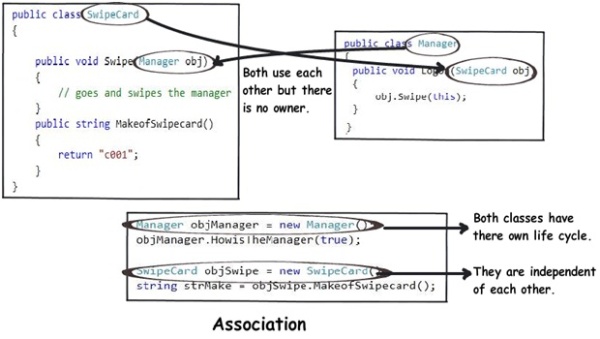Table of contents
Introduction
In this article, we will try to understand three important concepts: association, aggregation, and composition.
We will also try to understand in what kind of scenarios we need them. These three concepts have really confused a lot of developers and in this article, my attempt would be to present the concepts in a simplified manner with some real world examples.
Extracting real world relationships from a requirement
The whole point of OOP is that your code replicates real world objects, thus making your code readable and maintainable. When we say real world, the real world has relationships. Let’s consider the simple requirement listed below:
- Manager is an employee of XYZ limited corporation.
- Manager uses a swipe card to enter XYZ premises.
- Manager has workers who work under him.
- Manager has the responsibility of ensuring that the project is successful.
- Manager's salary will be judged based on project success.
If you flesh out the above five point requirement, we can easily visualize four relationships:-
- Inheritance
- Aggregation
- Association
- Composition
Let’s understand them one by one.
Requirement 1: The IS A relationship
If you look at the first requirement (Manager is an employee of XYZ limited corporation), it’s a parent child relationship or inheritance relationship. The sentence above specifies that Manager is a type of employee, in other words we will have two classes: parent class Employee, and a child class Manager which will inherit from the Employee class.
Note: The scope of this article is only limited to aggregation, association, and composition. We will not discuss inheritance in this article as it is pretty straightforward and I am sure you can get 1000s of articles on the net which will help you in understanding it.
Requirement 2: The Using relationship: Association
Requirement 2 is an interesting requirement (Manager uses a swipe card to enter XYZ premises). In this requirement, the manager object and the swipe card object use each other but they have their own object life time. In other words, they can exist without each other. The most important point in this relationship is that there is no single owner.

The above diagram shows how the SwipeCard class uses the Manager class and the Manager class uses the SwipeCard class. You can also see how we can create objects of the Manager class and SwipeCard class independently and they can have their own object life time.
This relationship is called the “Association” relationship.
Requirement 3: The Using relationship with Parent: Aggregation
The third requirement from our list (Manager has workers who work under him) denotes the same type of relationship like association but with a difference that one of them is an owner. So as per the requirement, the Manager object will own Worker objects.
The child Worker objects can not belong to any other object. For instance, a Worker object cannot belong to a SwipeCard object.
But… the Worker object can have its own life time which is completely disconnected from the Manager object. Looking from a different perspective, it means that if the Manager object is deleted, the Worker object does not die.
This relationship is termed as an “Aggregation” relationship.

Requirements 4 and 5: The Death relationship: Composition
The last two requirements are actually logically one. If you read closely, the requirements are as follows:
- Manager has the responsibility of ensuring that the project is successful.
- Manager's salary will be judged based on project success.
Below is the conclusion from analyzing the above requirements:
- Manager and the project objects are dependent on each other.
- The lifetimes of both the objects are the same. In other words, the project will not be successful if the manager is not good, and the manager will not get good increments if the project has issues.
Below is how the class formation will look like. You can also see that when I go to create the project object, it needs the manager object.

This relationship is termed as the composition relationship. In this relationship, both objects are heavily dependent on each other. In other words, if one goes for garbage collection the other also has to be garbage collected, or putting from a different perspective, the lifetime of the objects are the same. That’s why I have put in the heading “Death” relationship.
Putting things together
Below is a visual representation of how the relationships have emerged from the requirements.

The source code
You can download the sample source code for this article.
Summarizing
To avoid confusion henceforth for these three terms, I have put forward a table below which will help us compare them from three angles: owner, lifetime, and child object.
| | Association | Aggregation | Composition |
| Owner | No owner | Single owner | Single owner |
| Life time | Have their own lifetime | Have their own lifetime | Owner's life time |
| Child object | Child objects all are independent | Child objects belong to a single parent | Child objects belong to a single parent |
Detailed Video on Association, Aggregation, and Composition
Thanks for reading my article.
For further reading do watch the below interview preparation videos and step by step video series.
